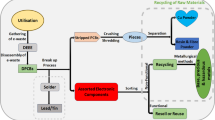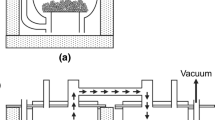Abstract
We study protective coatings based on modified epoxide oligomers with addition of a waste of the “Khimvolokno” and “Azot” plants and on synergists, derivatives of benzamidazole. Waste utilization is shown to provide a 50% economy of deficient epoxide resins. The developed composition of inhibited protective coatings guarantees the enhancement of their anticorrosive activity at the expense of partial inhibition effects (blocking mechanism, in particular). The augmentation of the chemical resistance of steel with inhibited protective coatings to low-cyclic fatigue is related to the plasticization of polymeric metal-chelate films formed on the metal surface.
Similar content being viewed by others
References
V. I. Chernaya, S. Ya. Mikhal'kov, and I. G. Lukashenko,Application of Wastes from Chemical Plants to the Manufacture of Paintwork Coatings [in Russian], VSNTO, Chernigiv (1986).
I. L. Rosenfeld and F. I. Rubinstein,Anticorrosive Base Coatings and Inhibited Paintwork Coatings, [in Russian], Khimiya, Moscow (1980).
I. L. Rosenfeld, F. I. Rubinstein, and K. A. Zhigalova,Metal Protection Against Corrosion with Paintwork Coatings [in Russian], Khimiya, Moscow (1987).
M. P. Livshits and B. I. Pshiyalkovskii,Paintwork Materials [in Russian], Khimiya, Moscow (1982).
M. N. Fokin and Yu. V. Emelyanov,Protective Coatings in Chemical Industry [in Russian], Khimiya, Moscow (1981).
Yu. I. Babei and N. G. Soprunyuk,Steel Protection Against Corrosion-Mechanical Failure [in Russian], Tekhnika, Kiev (1981).
O. N. Romaniv and G. N. Nikiforchin,Mechanics of Corrosion Failure of Structural Alloys [in Russian], Metallurgiya, Moscow (1986).
G. V. Karpenko, K. B. Katsov, I. V. Kokotailo, et al.,Low-Cyclic Fatigue of Steels in Working Fluids [in Russian], Naukova Dumka, Kiev (1977).
I. I. Vasilenko and R. K. Melekhov,Corrosion Cracking of Steels [in Russian], Naukova Dumka, Kiev (1977).
L. S. Saakiyan, A. P. Efremov, I. A. Soboleva, et al.,Oil-Production Equipment Protection Against Corrosion [in Russian], Nedra, Moscow (1985).
I. S. Shparber,Sulfide Cracking of Steels and Its Prevention in the Oil and Gas Industry [in Russian], VNIIÉgasprom, Moscow (1970).
N. E. Legezin, N. P. Glazov, G. S. Kesselman, et al.,Protection of Production Constructions against Corrosion in the Gas and Oil-Refinery Industry [in Russian], Nedra, Moscow (1973).
M. A. Shluger, F. F. Azhogin, and E. A. Efimov,Corrosion and Metal Protection [in Russian], Metallurgiya, Moscow (1981).
E. S. Ivanov,Inhibitors of Metal Corrosion in Acid Media [in Russian], Metallurgiya, Moscow (1986).
Yu. L. Babei, V. H. Starchak, Yu. A. Klyachko, et al, “Estimation of efficiency of the action of corrosion inhibitors,”Zashch. Met.,12, No. 3, 332–333 (1976).
V. H. Starchak,The Complex System of Control and Estimation of Efficiency of the Protection of Structural Steels Against Corrosion-Mechanical Failure in Hydrogen-Charging Media [in Russian], VSNTO, Chernigiv (1983).
V. H. Starchak,Saving Reserves of Metal Resources [in Ukrainian], Znanya, Kiev (1983).
V. H. Starchak, “Particular effects of the inhibition of H2S-corrosion of steels,”Metal Protection,28, No. 3, 509–512 (1992).
L. M. Antropov, E. M. Makushin, and V. F. Panasenko,Inhibitors of Metal Corrosion [in Russian], Tekhnika, Kiev (1981).
S. M. Reshetnikov,Inhibitor of Metal Acid Corrosion [in Russian], Khimiya, Leningrad (1986).
M. N. Fokin and K. A. Zhigalova, in: Ya. M. Kolotyrkin (editor),Methods for Metal Corrosion Tests [in Russian], Metallurgiya, Moscow (1986).
Ya. M. Kolotyrkin and G. M. Florianovich, in:Progress in Science and Technology [in Russian], Electrochemistry, Vol. 7, VINITI, Moscow (1971), pp. 5–64.
V. H. Starchak, N. A. Kuzina, V. K. Bagin, et al., “Partial effects of the inhibition of acid corrosion of steels,”Zashch. Met.,31, No. 6, 640–642 (1995).
V. H. Starchak, N. O. Kuzina, and V. K. Bagin, “On the efficiency of waste utilization for anticorrosive protection,”Fiz.-Khim. Mekh. Mater.,33, No. 2, 112–114 (1997).
V. H. Starchak, L. D. Kosukhina, and A. N. Krasovskii, “Chemical hydrogenation under steel H2S-corrosion,”Zashch. Met.,23, No. 1, 111–114 (1987).
V. H. Starchak, B. A. Priimenko, L. I. Boiko, et al., “Inhibitory activity of mono-, bi-, and tricyclic derivatives of imidazole,”Zh. Prikl. Khim.,70, No. 5, 769–773 (1997).
Additional information
Technological Institute, Chernigiv. Translated from Fizyko-Khimichna Mekhanika Materialiv, Vol. 35, No. 1, pp. 90–94, January–February, 1999.
Rights and permissions
About this article
Cite this article
Syza, O.I., Starchak, V.H., Boiko, L.I. et al. Utilization of a multitonnage wastes in compositions based on modified epoxide oligomers. Mater Sci 35, 100–107 (1999). https://doi.org/10.1007/BF02355607
Received:
Issue Date:
DOI: https://doi.org/10.1007/BF02355607




